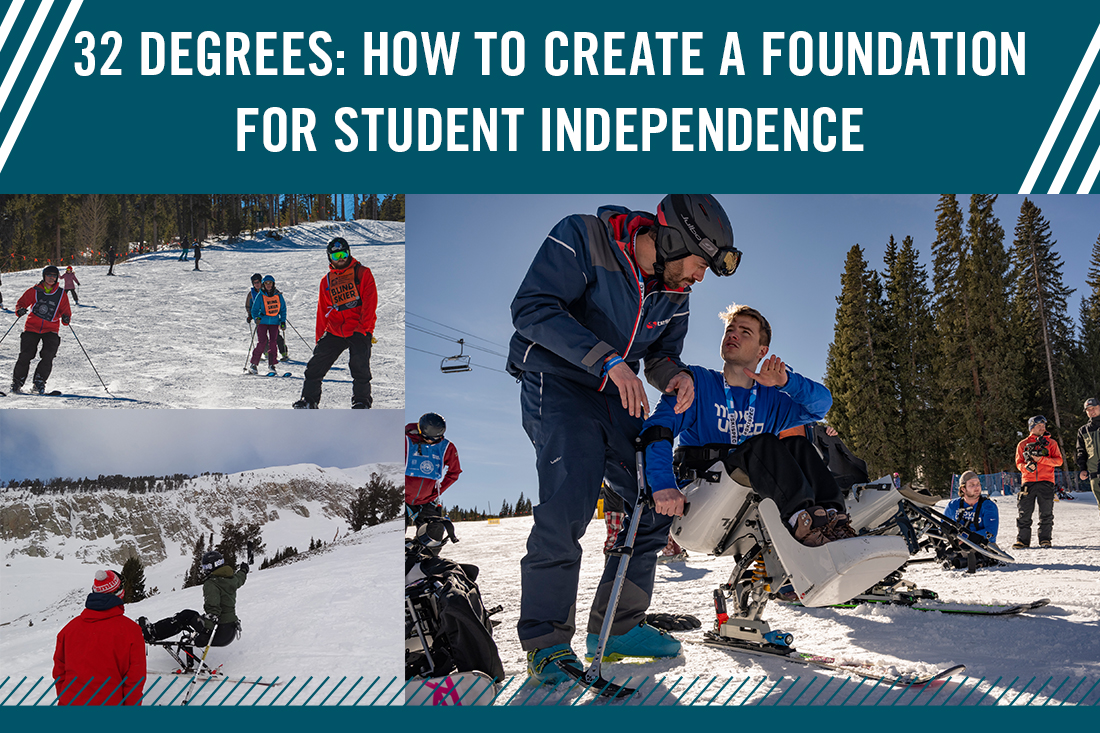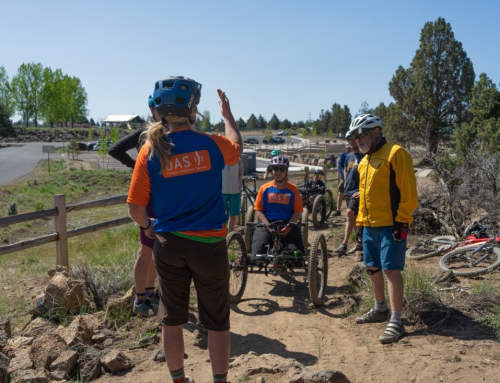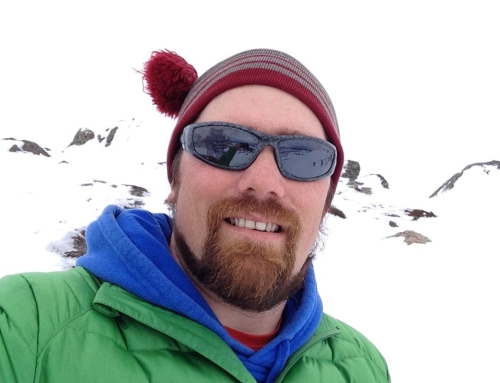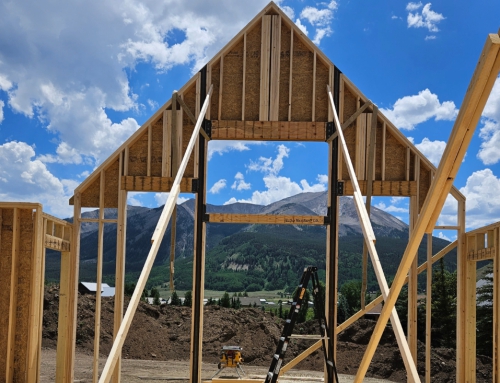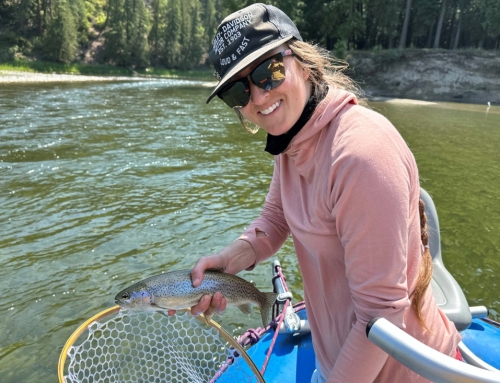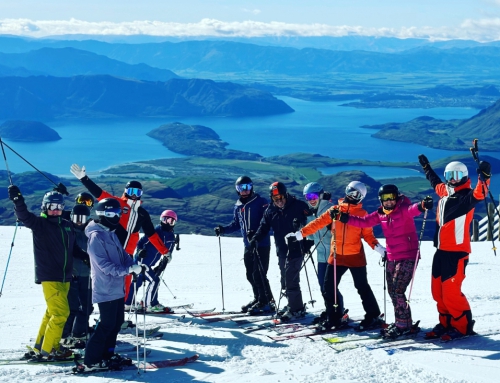32 Degrees: How to Create a Foundation for Student Independence
This article by Trevor Hildebrand appears in the Spring 2024 Issue of 32 Degrees. You can read the entire digital edition by logging in and visiting the 32 Degrees page on our website.
Reading PSIA-AASI Adaptive Team Coach Geoff Krill’s Fall 2023 article, “Embrace Opportunity to Set a Foundation for Independence,” got me thinking about insight I’ve gained over the last 20 seasons of instructing in both adaptive and mainstream programs. Geoff’s article covers the what and why behind promoting independence; I want to offer some guidance about the how. Here are a few lessons I’ve learned in three categories – student abilities, goal-setting, and terrain – with actionable items you can work on implementing this season and beyond.
STUDENT ABILITIES
You can’t promote independence unless you understand the student’s abilities and current state of being. That’s now an overarching element of every lesson I teach.
In the past: I made assumptions based on the student’s intake paperwork or the way they walked in, spent little time gaining an understanding of their abilities, and got out on snow quickly. This caused issues in the lessons, including equipment adjustments in a cold environment, taking them too high on the mountain, assuming they couldn’t do things that they could, or assuming they understood things that they didn’t. Without a clear picture of student abilities, you won’t be able to help them reach their potential.
Now: I take the time to understand the student more fully by assessing CAMP, that is, the cognitive, affective, medical, and physical factors that may have bearing on the lesson. If I understand their abilities and medical considerations (including medications they take), I have a great baseline from which to work. I have a grasp of their true skills so we can go to appropriate terrain to work on developing those skills.
Learning student strengths – which you can use to overcome their challenges – will expedite your ability to steer the learning process to set them up for success. Performing a proper assessment allows you to choose the right drills and tasks based on their abilities and strengths and helps the lesson progress more effectively. I trust but verify what others tell me my student can/can’t do, as I have found most students have more skills and abilities than we think.
How to Avoid My Mistakes:
- Begin by playing. Use games, activities, and tasks to explore the student’s physical abilities: bilateral movements, fine and gross motor control, range of motion, and strength.
- Play more. Jokes, activities that involve following directions, such as Red Light-Green Light or Simon Says, can help identify the student’s cognitive processing. Create challenges!
- Ask questions. To learn about the student’s abilities, why not ask them (and/or their caregivers)? Inquire about things that motivate them, as well as their worries and fears. And, of course, find ways to quickly alleviate their fears to create the space for learning.
GOAL-SETTING
All lessons benefit from setting realistic and achievable goals that instill or boost student confidence in their abilities. This sets a foundation for success and greater independence.
In the past: When I was a newer instructor, the opening dialog in lessons often went something like this:
Me: What do you want to do today?
Student: Have fun!
Me: Great! Let’s go skiing!
I’ll be the first to admit that goals were not a driving force in my lessons. I figured as long as my students smiled and had fun, the rest didn’t matter. I drove numerous bi-skis with no client interaction, tethered too many stand-up skiers and riders, and overcompensated in numerous other ways to get students to move up higher on the mountain without being independent.
The student ultimately learned very little and didn’t progress quickly toward their goals, if they even had them. I remember fully supporting a young girl down the hill for five days to get her higher on the mountain, with no reason except to hear her giggle (which she did in ample amounts on the lower mountain, anyway).
Now: I know that goals are vitally important. After all, if you don’t know what the student’s goals are, how do you know that you’re fulfilling their desires and helping them get to where they want to be? If your student doesn’t have goals (or they or their caregivers can’t articulate them), every lesson offers a great opportunity to help them develop some.
How Student Goals Take Shape
I’ve learned that there may be five or more vested parties helping shape my student’s goals: the student, the student’s caregiver(s), the program I work for, me as the instructor, and even past instructors who helped drive the process. Regardless of where goals come from, I find that, to be useful, they must be divided into three groups: short-term, mid-term, and long-term.
I see short-term goals as those we’ll strive to hit that day. This typically includes working on a particular skill through various exercises to have an immediate outcome of turn improvement, stopping, or being able to slide on new terrain safely. Mid-term goals are those we can achieve this season, and I consider long-term goals to be those that are two or more seasons out.
In contrast to that opening dialogue I used to have with students, here’s how it might go now:
Parent: I want little Johnny to ski black terrain by tomorrow, so we can ski with him.
Me (having assessed that Johnny is only comfortable on the Magic Carpet and cannot stop independently on command): That’s a great long-term goal. Johnny currently needs hands-on assistance on the Magic Carpet, so it will take time to get there… maybe even a year or two. We can work toward that goal today by helping him develop the ability to steer his feet to make independent turns to a stop. That will give him skills necessary to progress toward your goals and get him safely down the carpet independently. I’m excited to help him learn to turn independently, stop independently, and build his confidence – all along the pathway to black runs.
Parent: Well… if you think that’s best. He seems to be having fun and keeping him safe is the most important thing.
Me: Let’s plan on meeting back down here at the base just before the lesson ends for a last run together. I can show you all the things Johnny has learned, and what you can do to help him get closer to that long-term goal as a family.
Little Johnny might not say a word, but the smile and look of relief is often all I need to know the goal is a good one. In working with the student and caregiver(s) on short-, mid-, and long-term goals, a strong relationship develops and the partnership lasts for years. Even getting the parent(s), caregiver(s), and student to work on skills at home is critical to achieving the goals.
How to Avoid My Mistakes:
- Ask the parents/caregivers what their goals are for the lesson.
- Ask the student what their goals are for the lesson.
- Create your own student goals for the lesson (that support A and B).
- Help the student and caregiver(s) modify their expectations, if necessary, to realistic short-term goals.
- Rather than make promises on what you will accomplish that day, spell out that you’ll be working on specific skills that will help develop the student’s sliding and get them closer to their mid-term and long-term goals.
TERRAIN
Never underestimate how your choice of terrain can influence your student’s ability to learn. Taking on too much, too soon often puts up a roadblock on the path to independence.
In the past: Sometimes I would go where the student wanted (whether they were ready or not), and sometimes I would, on my own accord, take them up onto the mountain before they were ready.
The outcomes were never ideal. Unable to control their speed or make turns, students were often emotionally anxious or scared (hence, bracing in a huge wedge, descending in a heelside sideslip on their bottom, or opting for continual mono-ski falls into the hill to avoid the turn). The lessons were not effective, and I did more harm than good.
Now: Before I go anywhere new on the mountain, I understand my student’s whole being through a solid assessment. I make sure their abilities align with what will be coming: steeper terrain, narrower terrain, more people, a more challenging lift, etc. For each step up (in terrain or lift choice), they must have demonstrated a competency in the skills that line up with the skills necessary to safely and properly execute that step.
For example, when we go from the carpet to a lift, the student must be able to independently turn right, turn left, and stop – all on command and/or when necessary from a safety perspective. In the adaptive world, I may address limitations in their abilities with some type of assistance (equipment, maneuver, etc.) – but only if they don’t have the ability to do so unaided and only taking them onto terrain where they can still contribute to their fullest extent possible.
Don’t Get Caught in Terrain Trap
These are the telltale outcomes of taking students on terrain that’s above their comfort and/or skill level (known as over-terraining):
- The student’s learning wanes or stops.
- The student reverts to old habits and defensive techniques, causing them to practice the wrong thing and regress in their improvement.
- In response to bad experiences, students often get frustrated and/or quit.
- Sit-ski students soon learn that you will do everything for them; some may stop trying and just show up for the ride.
If in doubt about whether any particular terrain is inappropriate, don’t go there. Figure out what skills the student needs to be successful and take it step by step. If you think you shouldn’t do it (i.e., drive a bi-ski through the woods or tether a run that you “think” you can go down), don’t do it!
I do believe that slightly over-terraining has its place at the appropriate time on the appropriate run with the appropriate student, but that is far outside the scope of this article.
I’ve found that most students improve more quickly in the intermediate and advanced zone when you spend the right amount of time with them in the novice zone. If your student doesn’t have a good foundation of the fundamentals, they’ll likely improve more slowly and develop bad habits they’ll need to correct before learning new/more advanced skills.
How to Avoid My Mistakes:
- Spend more time on the novice slopes, finding ways to challenge the student’s balance and pushing for correct skill development.
- Stay lower on the mountain than you think you need to and make it engaging! The student won’t get bored with the terrain if you truly connect with them and make it fun.
- If you see defensive sliding habits forming, you’re very likely on terrain that’s too difficult. Move to easier terrain.
- Find five different ways to make a single task/exercise fun. Then, do it again with another task, and another task. (If you have a hard time with this, take a Children’s Specialist course or ask a children’s instructor for pointers.)
- For those students who really believe they want to go to harder terrain but aren’t quite ready for it, pick two or three very hard tasks that they do not have the skills for but will need on harder terrain. Tell them that once they can do them flawlessly on easier terrain, they can go up higher on the mountain. Set them up for safe failure. Sometimes the best outcomes come from challenging students – but in a careful and considered way.
WRAPPING IT UP
I hope you learn from my mistakes and craft your lessons – whether in the adaptive or mainstream realm – into something amazing that fits each individual student. Focus on their ability to achieve success independently and move at the pace – and on terrain – that’s right for them.
My suggestions aren’t hard to implement; with intention and thought you’ll be more adept at giving your students the confidence and skills to explore whatever adventures they want to take on.
Trevor Hildebrand lives in Columbia Falls, Montana, and is an adaptive examiner for PSIA-AASI’s Northern Rocky Mountain Region. He is also a traveling adaptive ski and adaptive snowboard clinician.

